All About Corner Clamps

The clamp is an indispensable part in the arsenal of tools of every master. However, very often this device is used in everyday life, for example, by amateurs to design everything with their own hands. It is for such work that the corner clamp was created, which will certainly facilitate your work.
What it is
An angle clamp is a device that acts as a so-called clamp to ensure stability and fixation of two parts... Most often used in workshops, but can also be great in everyday life.
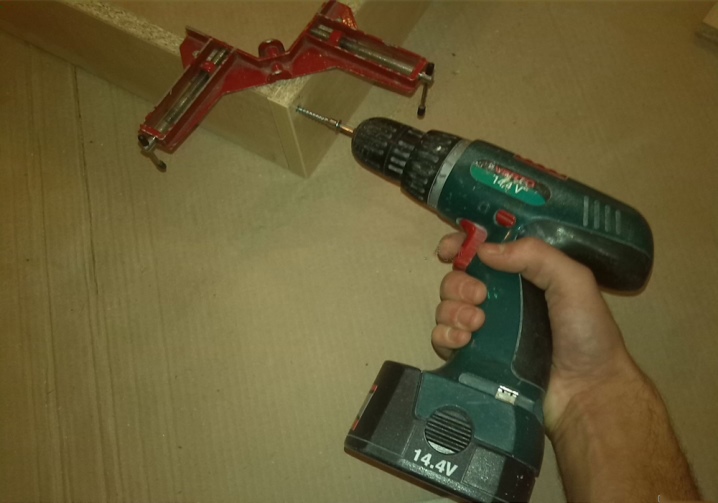
It is possible to highlight the features that emphasize the main advantages in the use of these clamps:
- ease and simplicity in transportation;
- "Third hands" in the workshop;
- stable clamp;
- the ability to work with all kinds of materials (metal, glass, wood, etc.);
- the ability to mount this tool with your own hands.

The angle clamp consists of the following structural elements:
- terminal with two parts as an auxiliary stop element;
- movable block;
- a mechanism that provides mobility and the ability to exert;
- propeller for gripping the lever and fixing it;
- parts that are intended for less gripping of the product are runners.
Understanding the design of the angle clamp will help you do it yourself and use it correctly, especially if you are using the device at home.
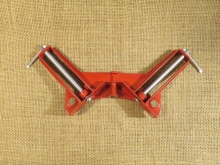
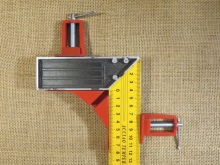

Clamp advantages:
- long term of work (the main thing is to correctly distribute the applied efforts, and then such a clamp will serve you for several years);
- reliability and durability (adhering to all the rules for using the tool, you will achieve the best stability);
- practicality (will simplify your work and become a so-called “third-hand” substitute);
- wide range of applications (useful for you in absolutely any workshop, as well as for installing furniture; in addition, there are types of clamps made of completely different materials, which makes their functionality much diverse);
- low cost (moreover, if you do not want to spend money on purchasing this model, you can use the homemade clamp scheme, which is proposed in this article).
It can be noted that a number of advantages once again confirm the functionality and practicality of this device, which is suitable for both professional and amateur use.


Appointment
The angle clamp is used for the following purposes:
- for fixing structures at an angle of 90 degrees (there are also accessories for use at different angles);
- for circumcision details at the angle you need;
- when installing drawers, cabinets and other furniture that needs corner fixing;
- replaces "Third hands";
- applied for product design from various materials (wood, plastic, steel and glass).



The angle clamp has gained wide popularity and demand among consumers, mainly because this device is a very reliable assistant in fastening two parts of a product.
It is this model that is practical for use in everyday life.
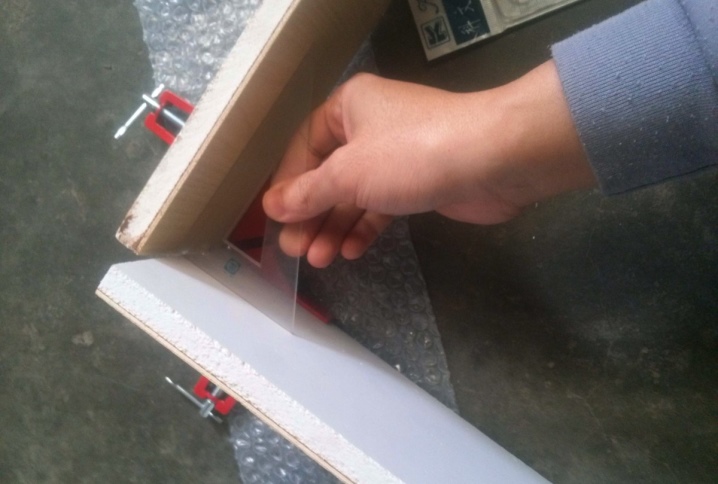
Model overview
Depending on the functional features, material and specifics of use, several types of corner clamps can be distinguished.
- Clamp from 75 mm aluminum housing characterized by a rather uncomplicated structure.Consists of two metal (sometimes zinc) screws and two moving parts. With the help of a special hole, it is possible to install the clamp permanently in any carpentry workshop.
The functionality of this device is much wider than in other models.

- Plywood clamps... Particle board (chipboard) is most often used to mount furniture, the fixation of which requires a durable tool for a 90-degree right angle. It is in such a situation that a self-made wooden clamp may be needed. This device can be made from both chipboard and plywood, but it is important that its thickness is not more than one centimeter. The center of gravity is formed using a rectangular bar made of any wood material. You may also need a drill and a hacksaw.

- With the help of plywood, two triangles are made with sides of about 40 cm, while it is imperative to maintain a right angle. A hole of a certain size is created in the corner of each workpiece in order to correctly apply the clamps. After that, you can start using the design you made.
This device is perfect for making frames.

- Corner clamps designed for fixing metal products... Such clamps are made of metal, which is why they fix steel blanks much more reliably. This device can also be assembled by hand according to the same principle as the wooden version. For the best quality, a metal sheet with a density of at least one centimeter is used, which helps a strong and stable connection of the metal elements of the product. And in order to fix it more firmly, it may be necessary to weld some parts.
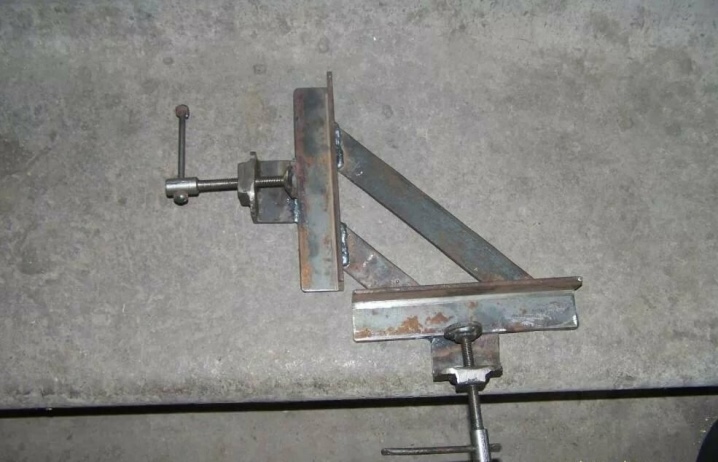
How to choose?
In order to choose the right clamp, it is necessary to take into account several important points.
- Material quality... Clamps are mainly made from metal alloys, since when they are applied, enormous forces are applied that not every material can withstand.
- Coarse thread on the fixture... This will help increase the strength and reliability of the fastening.
- The center of gravity should be as large as possible and not blend in with the rest of the device to avoid any distortion.
- Choosing the right handle will help you to ensure the comfort when using the tool. For convenience, manufacturers can equip the tool with rubber or wooden elements.

How to do it?
If you want to save money, but at the same time you cannot do without additional "third hands", then we can offer the option of a homemade clamp. It is quite easy to make such a device with the help of materials at hand.

- Prepare the necessary materials and blanks... You will need a metal sheet on which steel pipes 20 centimeters long are located. The pipes should be placed perpendicular to each other and then welded to the sheet from all sides. It is important to carefully weld each piece to ensure that the clamp is secure.
- Create Clamp Drawing... After welding all the parts, it is supposed to get rid of all unnecessary parts. In the next step, the remaining parts of the pipes will be soldered from above and below to the main ones. You will have to arrange the pieces of sheet metal in the same way, but so that they are parallel to each other. Another metal pipe will be used with a through hole in the middle. In the future, this scheme will be useful to you when creating a clamp.
- We mount the device and check the angle... Be sure to stock up on the necessary elements: a bolt, a few nuts, a handle, a clamp.
From the corner of the triangle made, you need to draw the so-called bisector. And at this angle, a pipe with a through hole is installed. After that, two nuts and a bolt must be attached to this hole. One nut is screwed on until the pipe is attached, and the other is tightly clamped by hand from the other end.Using welding, you need to attach them to the product.
The bolt from this hole should be easily unscrewed. Next, a pre-prepared centimeter tube will come in handy so that it can pass between parallel triangular metal sheets.
Then take a profile pipe in the same size as the previous part with a hole of about one centimeter. Slide a nut onto this U-shaped workpiece with a small space to allow the stud to twist easily. It is necessary to solder the nut to the stud first, and later - a piece of a centimeter pipe to the U-shaped part, making holes on the second particle. - Next step - joining the second and third parts by welding. Weld the profile tube with the pre-fitted stud to the first piece.
- We get a ready-made clamp... You can test a DIY fixture.

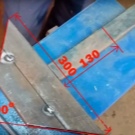
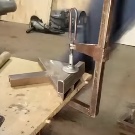
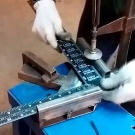


How to use?
Of course, the angle clamp is a practical tool that makes work easier in every workshop. However, its use requires a fairly reliable and strong fixation, so you need to adhere to the rules for using this model.
You need to focus on ensuring that the clamp completely and evenly "sits" on the surface of the product, while maintaining an angle of 90 degrees.
When compressing, evenly distribute the applied forces, otherwise you can damage the area of the structure being manufactured.


It must be remembered that the clamp needs stable fixation, especially when machining.
In another situation, the work you are doing will become much more complicated, since the part will not be well fixed.
Using such a tool is quite simple, just remembering a few basic points that will help you do your work better.


How to use corner clamps - video below.













The comment was sent successfully.